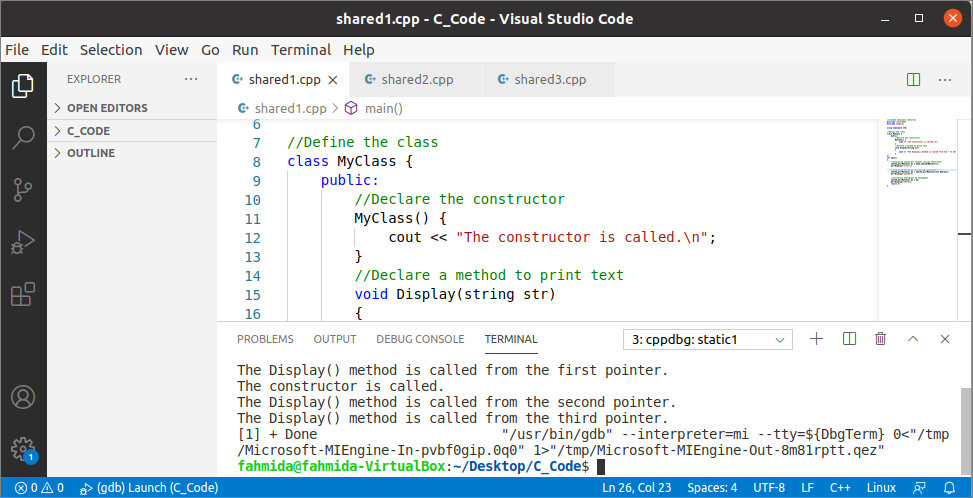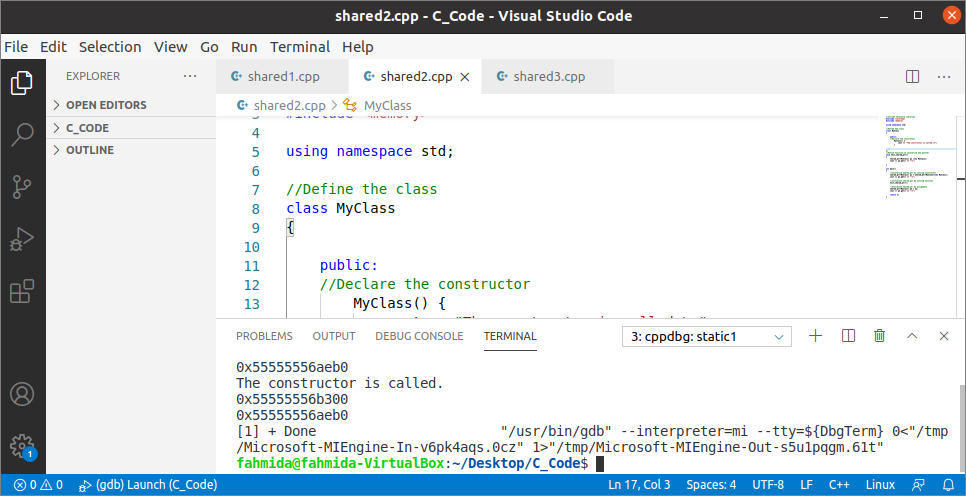Example 1: Declare Shared Pointer in Different Ways
Three different ways to declare a shared pointer are shown in the following example. A class with a constructor and a public method have been declared in the code. The constructor will print a message when a new shared object is created with the constructor. The Display() method will print messages based on the calling shared pointer object. Here, the first shared pointer object has been created without calling the constructor. The second shared pointer object has been created by calling the constructor. The third shared pointer has created by assigning the first shared pointer. The Display() method has been called three times by using three shared pointer objects.
#include <iostream>
#include <memory>
usingnamespacestd;
//Define the class
classMyClass {
public:
//Declare the constructor
MyClass() {
cout<<"The constructor is called.\n";
}
//Declare a method to print text
voidDisplay(string str)
{
cout<<"The Display() method is called from the "<< str <<" pointer.\n";
}
};
intmain()
{
//Initialize shared_ptr without calling constructor
shared_ptr p1 = make_shared();
p1->Display("first");
//Initialize shared_ptr by calling constructor
shared_ptr p2 = shared_ptr(newMyClass);
p2->Display("second");
//Initialize shared_ptr by assignment
shared_ptr p3 = p1;
p3->Display("third");
return0;
}
Output:
The following output will appear after executing the above code. The constructor has called at the time of second object creation only. So, the message of the constructor has been printed only one time:

Example 2: Print the Stored Shared Pointer Location
The get() function shared pointer is used to return the stored, shared pointer location. The following example will print the location of the stored, shared pointers that are created by the class and the function. Here, a class with a constructor has been defined to be used for creating a shared pointer. A function has been declared to create a shared pointer and print the shared pointer location using the get() function. In this code, the first shared pointer has been created using the class, the second shared pointer has been created using the function, and the third shared pointer has been created by assigning the first pointer.
#include <iostream>
#include <memory>
usingnamespacestd;
//Define the class
classMyClass
{
public:
//Declare the constructor
MyClass() {
cout<<"The constructor is called.\n";
}
};
//Define function to initialize the pointer
voidInit_shared_ptr()
{
shared_ptr p2 (newMyClass);
cout<<p2.get() <<"\n";
}
intmain()
{
//Initialize shared_ptr by calling constructor
shared_ptr p1 = shared_ptr(newMyClass);
cout<<p1.get() <<"\n";
//Initialize shared_ptr by calling function
Init_shared_ptr();
//Initialize shared_ptr by assignment
shared_ptr p3 = p1;
cout<<p3.get() <<"\n";
return0;
}
Output:
The following similar output will appear after executing the above code. In the output, the returned value of the get() function for the first and third shared pointers are the same. However, the second shared pointer is different:

Example 3: Count the Shared Pointer Objects
The following example depicts a way to count the number of objects pointed by a shared pointer after creating and destroying the pointer. A class with a constructor has been declared in the code. The first shared pointer has been created using the class, and the second shared pointer has been created using the first shared pointer. The number of objects pointed by both shared pointers before and after calling the reset() function has been printed later.
#include <iostream>
#include <memory>
usingnamespacestd;
//Define the class
classMyClass {
public:
//Declare the constructor
MyClass() {
cout<<"The constructor is called.\n";
}
};
intmain()
{
//Initialize the first shared_ptr by calling constructor
shared_ptr p1(newMyClass);
//Display the number of shared_ptr objects by the first pointer
cout<<"p1 pointing to "<< p1.use_count() <<" object(s).\n";
//Initialize the second shared_ptr using the first shared_ptr
shared_ptr p2(p1);
//Display the number of shared_ptr objects by the first and second pointers
cout<<"p2 pointing to "<< p2.use_count() <<" object(s).\n";
cout<<"p1 pointing to "<< p1.use_count() <<" object(s).\n";
//Remove the ownership of the first pointer from the shared_ptr object
p1.reset();
//Display the number of shared_ptr objects by the second pointer
cout<<"p2 pointing to "<< p2.use_count() <<" object(s).\n";
return0;
}
Output:
The following output will appear after executing the above code. The first pointer, p1, is pointing to one object after creation. After creating the second pointer, p2, using the first pointer, p1, both pointers are pointing to two objects for sharing the pointer. After calling the reset() function for the pointer, p1, one object has been destroyed, and the pointer, p2, is now pointing to one object only.

Conclusion:
The purposes of using a shared pointer in C++ have been explained in this tutorial by using simple examples. Creating shared pointers in different ways, getting stored shared pointer location, and counting the number of objects pointed by the shared pointers. I hope the C++ coders will be able to use the shared pointer in their code after reading this tutorial.
from Linux Hint https://ift.tt/3lyW9v5




0 Comments